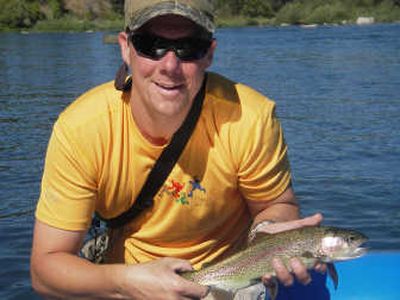State study finds far fewer redband trout

Redband trout are the Spokane River’s signature native fish, spotted beauties with a stripe that glows brick red during spawning season and a feisty attitude prized by sport anglers.
Scientists at the Washington Department of Fish and Wildlife suspected the population was in decline. It wasn’t until October that they realized how much.
A team spent nine days surveying the upper Spokane on a research boat, running a mild electric current through the water that temporarily stunned the fish and brought them to surface. The research team scooped out the redbands, counted, tagged and released them.
The numbers were startling.
In the 1980s and 1990s, fisheries managers estimated redband populations in the upper Spokane River at between 2,000 and 19,000 fish.
The October survey estimated fewer than 1,200 remain in the upper Spokane, which is defined as the reach above Upriver Dam. Each survey was conducted differently, which makes direct comparisons difficult, said Jason McLellan, a state fisheries biologist.
But one figure leaped out at researchers. In 1980, one stretch of the upper Spokane contained 222 redband trout per kilometer. In October, scientists counted 61 redbands per kilometer in the same stretch.
A reduction of nearly 75 percent is troubling, McLellan said. Redbands are a sentinel species for the agency. Their sensitivity to water quality makes them barometers of aquatic health.
Lower stretches of the Spokane River contain higher redband counts, but the populations are interconnected.
“When you’re looking at one of those trout, or handling one, you’re looking at thousands of years of genetic information and adaptation to this specific river,” said Jerry White Jr., conservation director for the Spokane Falls Chapter of Trout Unlimited.
White, a 46-year-old English teacher, fly fishes along the river in his West Central neighborhood. He’s caught and released 18-inch redbands.
“There’s not many urban places anymore that have an intact population of native coldwater fish right in their midst,” White said.
The “native” comes with an asterisk.
“We’re presuming they’re native,” said McLellan, adding, “we can’t say with 100 percent certainty.”
Recent DNA testing links the fish to the native Columbia River redband population, with only a small genetic influence from non-native hatchery trout that were introduced later to the Spokane River. But skeptics wondered how a native trout could have scaled Spokane Falls to reach the river’s upper stretches.
Scientists are still sorting out the reasons for the redband’s decline. But they point to competing demands on the river system, including boaters’ desire for a high summer level in Lake Coeur d’Alene; withdrawals from the Spokane Valley/Rathdrum Prairie aquifer for development; and wastewater discharges into the river.
Avista Corp. is in the midst of relicensing five hydroelectric dams on the River, and redbands figure prominently in the discussion.
Redbands spawn in early April, laying eggs in shallow gravel nests – called redds – along the shoreline. In early June the fry emerge.
The trout’s history evolved with the natural cycle of snowmelt and high spring flows, said Doug Robison, mitigation coordinator with the Washington Department of Fish and Wildlife. But in dry years, the flows for fish compete with filling Lake Coeur d’Alene in early June for summer recreation. Avista uses the Post Falls dam to regulate lake levels.
Fish and Wildlife Department officials suspect that the gravels that nurture young redbands are drying out, which kills the fish. Avista, in cooperation with state agencies, has been monitoring spawning activity since 1995. As part of the relicensing process, Avista agreed to a spawning protection plan.
“We’re trying to protect the redds as much as we possibly can,” said Tim Vore, an environmental specialist at Avista who works on river flow issues. “It’s a native fish stock that’s unique to this river system. It’s an asset we have, and it’s important that we protect it.”
Robison said state officials were hoping for stronger spawning protections.
The plan says that if more than half of the inventoried redds dry out during two consecutive years, Avista must manage flows to protect at least 70 percent of the redds the third year.
“It’s realistic to realize that there’s a balance between recreation and fish,” Robison said. The balance, Robison believes, is skewed toward recreation.
Other factors play a role in the redband’s decline. Kootenai County is one of Idaho’s fastest growing metro areas. Water withdrawals from the Spokane Valley/Rathdrum Prairie aquifer affect the underground recharging of the river, which influences flows and temperatures, Robison said.
Poaching and predation are also factors. Some anglers aren’t following the catch-and-release rules. And smallmouth bass appear to be feasting on the redbands.
The non-native bass were illegally introduced to Lake Coeur d’Alene. They spread into the river, where the redband trout became part of their diet.
McLellan, of the Fish and Wildlife Department, hopes to hire a graduate student to run a predation study this summer. In addition, the agency plans to repeat the redband survey on the upper Spokane this year and again in 2009. Last year, the department received $60,000 through the Bonneville Power Administration fish and wildlife mitigation to conduct the survey.
The additional research will give scientists a clearer picture of the redband’s status.
White, the fly fisherman, said he was awed when he learned the trout he could catch five minutes from his house were native. He’d like to see more people share in that wonder.
“I always assumed that they were planted fish,” White said.
“I see them as this beautiful story that we still have here, that has persevered through all these changes to the river,” he said. Fishing for redbands, White said, “is really only a vehicle for understanding something larger and more beautiful.”